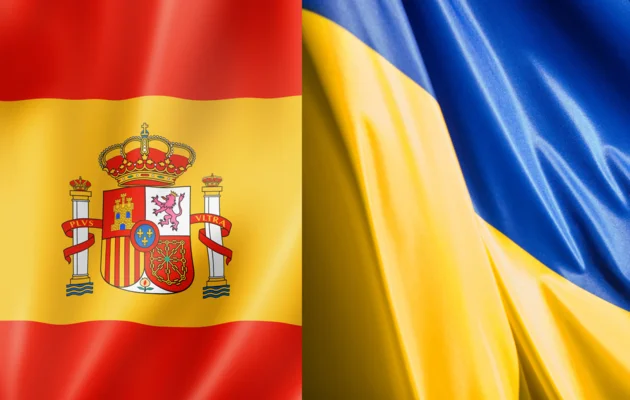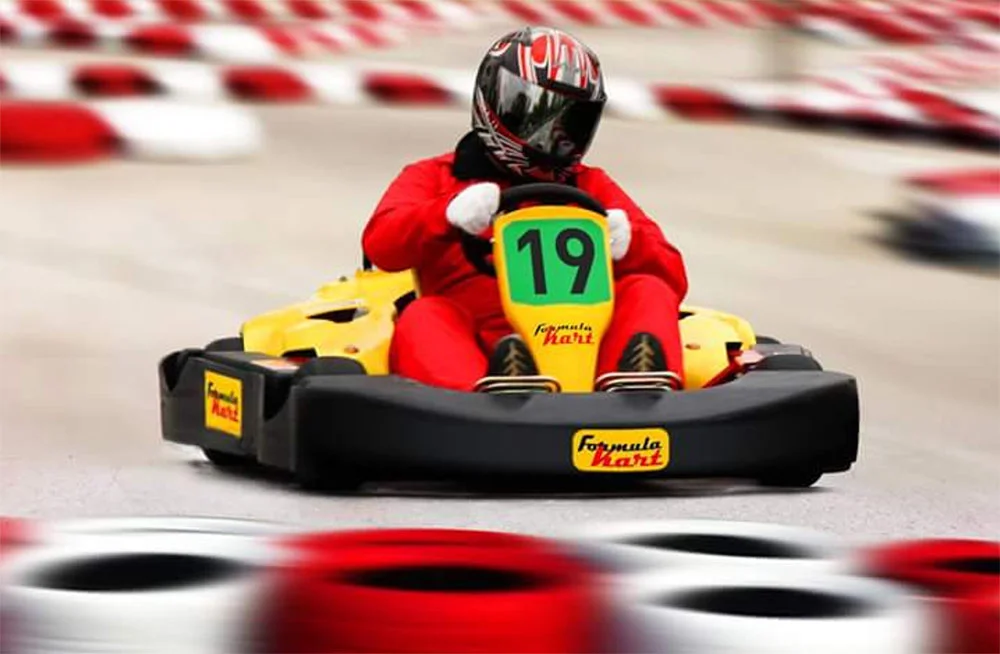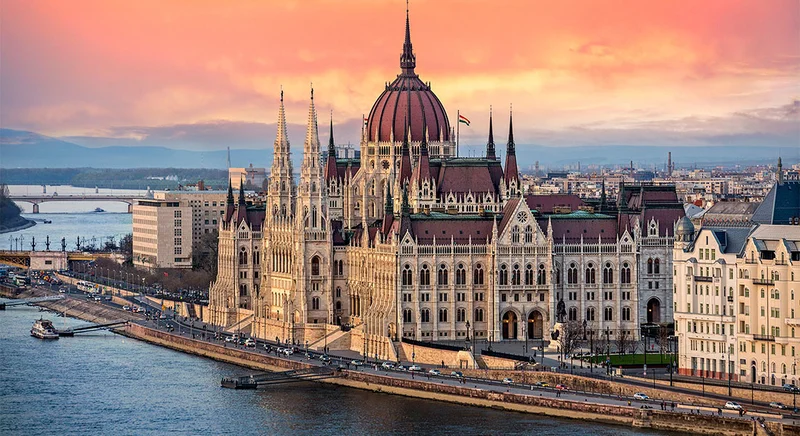
Budapest is known for its many attractions. The city is beautiful at any time of the year and is able to give an unforgettable experience. Often tourists come to the capital of Hungary for 2-3 days and ask themselves: what to see in Budapest? Therefore, the Travel Cost team has prepared a short guide, a guide to Budapest, which will help you get acquainted with the main attractions of the city and have a great time.
What to see in Budapest: day one
Budapest consists of two parts: Buda and Pest, separated by the Danube. The Buda side is more ancient, located on the hills. Pest is on the plain and there are more modern buildings, shopping malls and so on. We recommend starting your acquaintance with the city from Buda and ending with Pest.
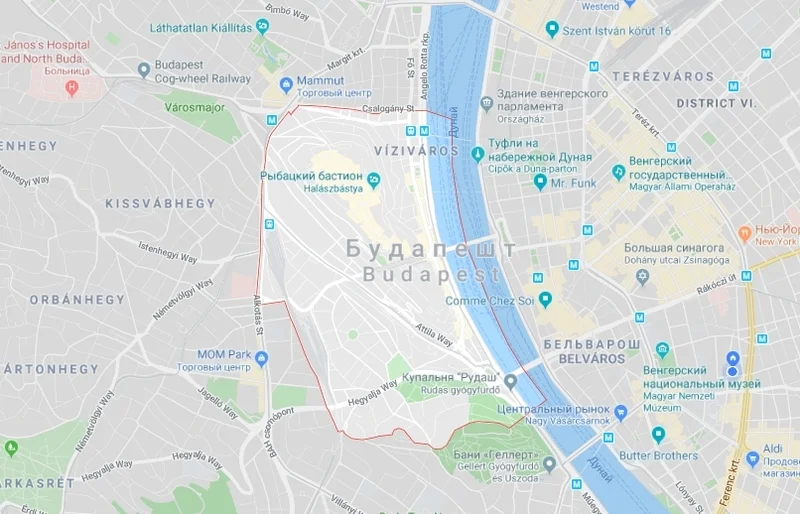
Buddha Side and Margaret Island
1. Mount Gellert
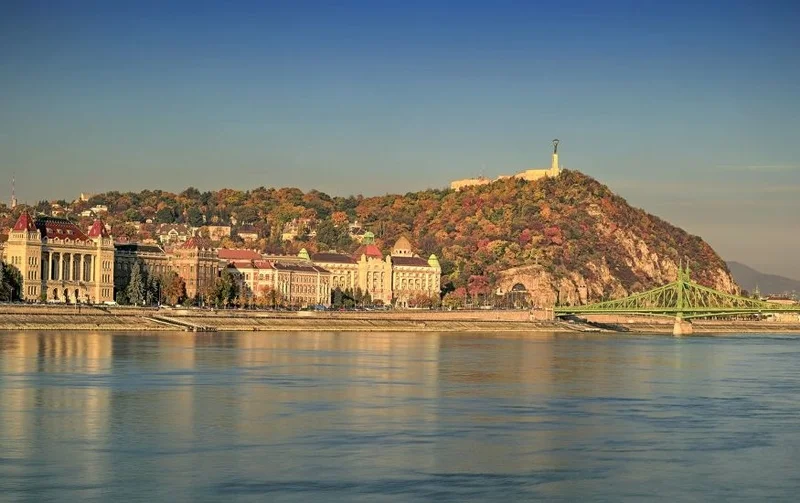
The height of the hill is 235 meters and it is one of the highest points in Budapest. What interesting things can be seen here: the Statue of St. Gellert, the Citadel, the Statue of Liberty, the Philosophical Garden, the Monument "King Buda and the Queen of Pest", the Cave Church.
2. Buda hill and fortress
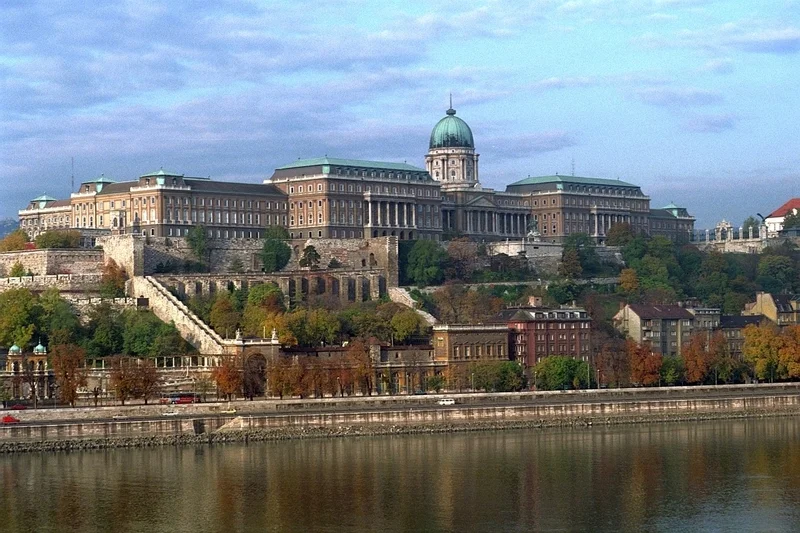
Buda Castle is an architectural complex on Buda Hill, where the Royal Palace, the Fisherman's Bastion, the Cathedral of St. Matthias and other attractions are located.
3. Fisherman's Bastion
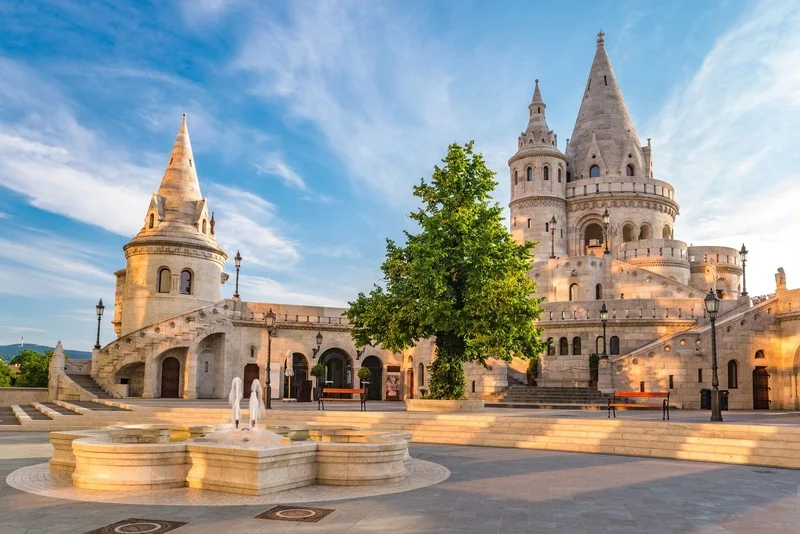
The fabulous white castle is part of Buda Castle, located on Castle Hill, which offers a magnificent view of the Danube and Pest. Topped with 7 towers, which symbolize the Magyar tribes, whose representatives founded the Hungarian state. It is part of the UNESCO World Heritage Site.
4. Monument to Saint Stephen
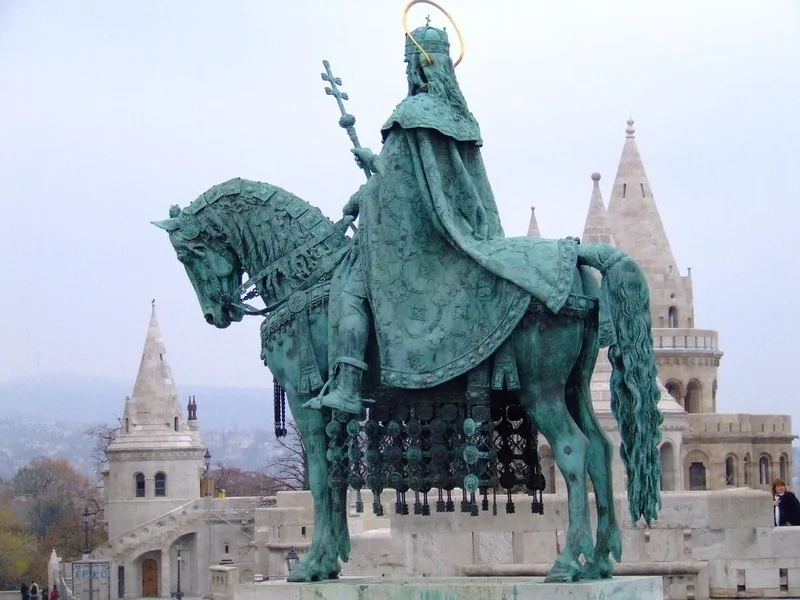
Near the bastion there is a monument to St. Stephen - the first Hungarian king. He is depicted sitting on a horse.
5. Royal Palace
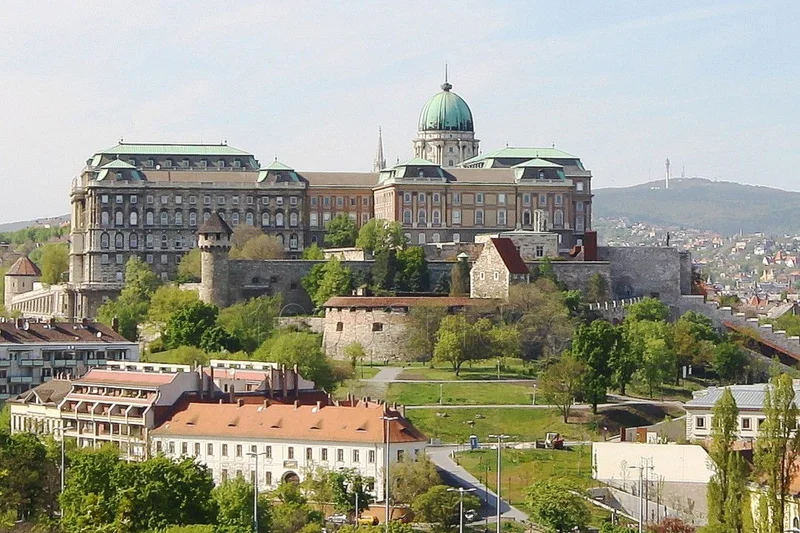
It is considered one of the main attractions of Budapest. It was built on a hill by order of King Bela 4 to protect against the Tatar-Mongol yoke. Now on the territory of the palace there are many fountains and statues. Be sure to pay attention to the column next to the entrance to the palace: there is a statue of the Turula bird on it. According to legend, the mother of the first ruler of the country gave birth to him from this bird. Although more than one legend goes around her. She is the symbol of the ruling dynasty. Also, look at: the fountain "Hunting of King Matthias", the statue of the commander Eugene of Savoy, who led the battle with the Ottoman army near Vienna.
6. Church of St. Matthias
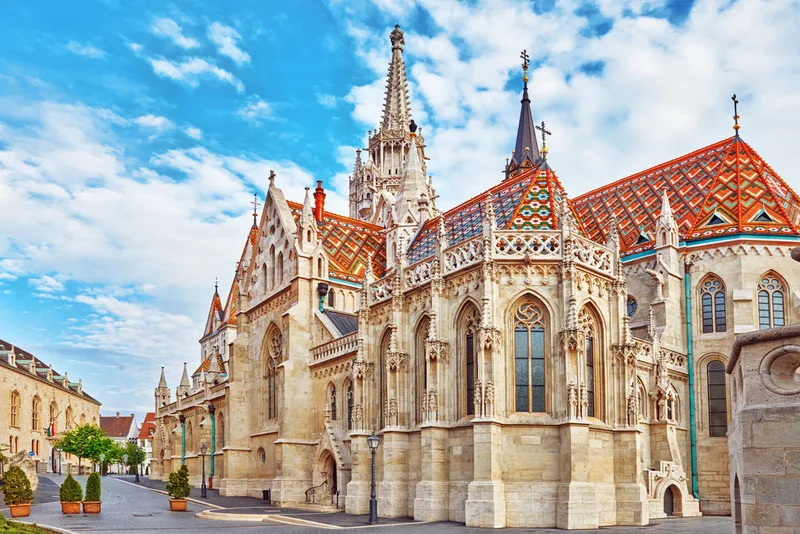
The Catholic Cathedral is located between the Fisherman's Bastion and Holy Trinity Square. The temple is dedicated to the Virgin Mary and was built in the 13th century. Naturally, the temple was reconstructed after many battles. But now it delights with its original architecture: a multi-colored roof, Gothic combined with Art Nouveau, rose windows. And almost the entire interior of the church has been preserved since the 19th century, after the last large-scale reconstruction. The main highlight of the interior is colored stained-glass windows.
7. House of Hungarian wines (museum of winemaking)
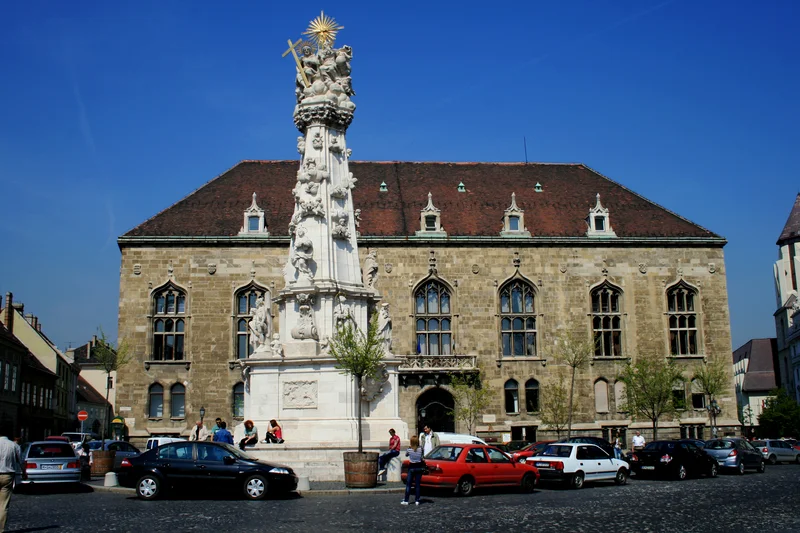
Located on the square of the Holy Trinity. The collection of the museum includes more than 700 varieties of wine, and about 55 varieties are offered for sampling. The exposition is located in the basement and is divided into several blocks: red wines, white wines, dessert wines and so on.
8. Budapest Castle Hill Funicular
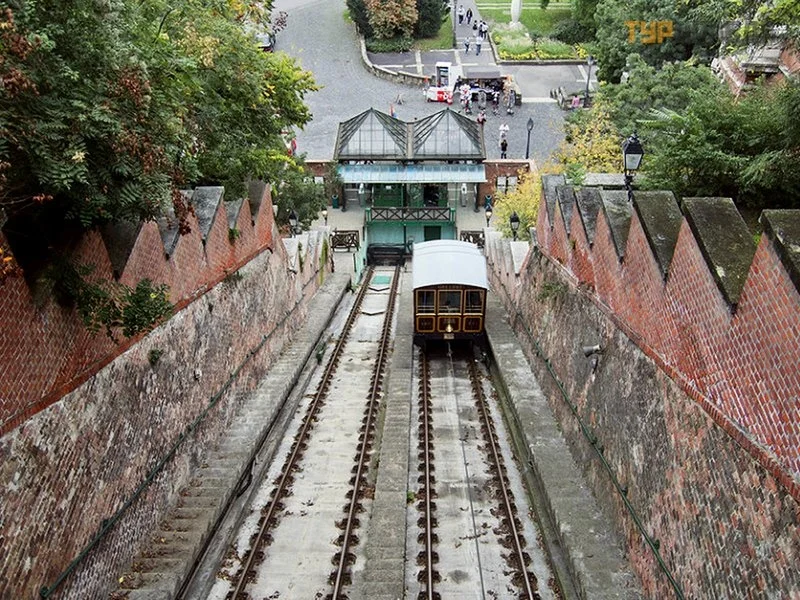
Connects Adam Clark Square and Buda Castle. Built in 1870, destroyed during World War II and rebuilt in 1984. Today, a bus runs through Buda Hill, but the funicular still remains a popular tourist attraction. It is considered the oldest functioning funicular in the world.
9. Labyrinth under the Castle Hill
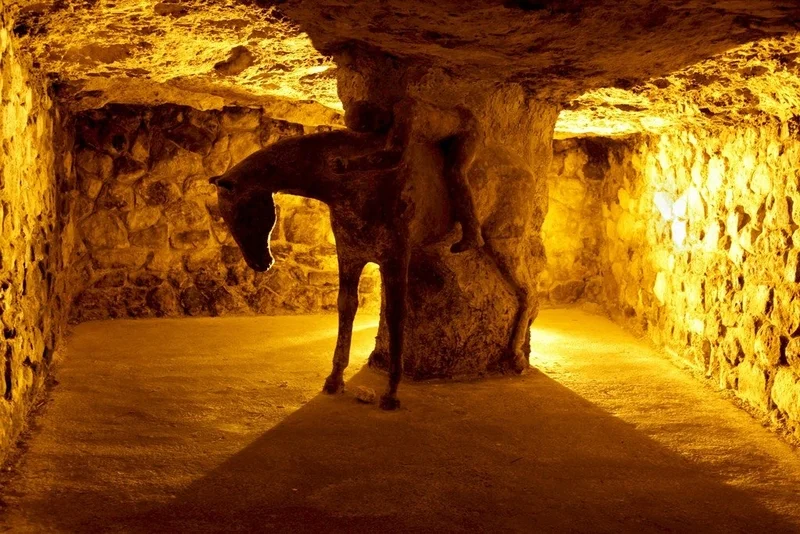
The labyrinth is a well-preserved medieval catacombs that are of natural origin. Depth - 16 meters, length about 1000 m. During the wars, the caves served as a shelter, and in peacetime they served as prisons, hospitals, wine cellars. Now the labyrinth is considered one of the sights of Budapest, here you can see wax figures in historical costumes, furnishings from different centuries, shackles, cages, and so on. Interestingly, in fact, the labyrinth is looped, so it is impossible to get lost in it.
10. Hospital in the Rock and Nuclear bunker
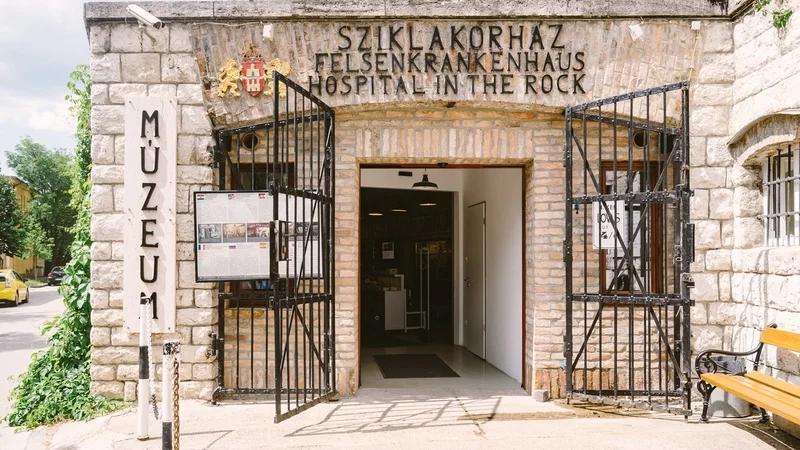
It is located in the cave system under Buda Castle. The hospital has played an important role in the history of Budapest. During the Second World War and the Hungarian Revolution of Independence in 1956, it was an emergency room. After the start of the Cold War in 1958, the facility was classified and converted into a nuclear bunker. The status of a secret kept right up to 2004. And since 2007, it has been open to the public and converted into a museum.
11. Church of Saint Mary Magdalene
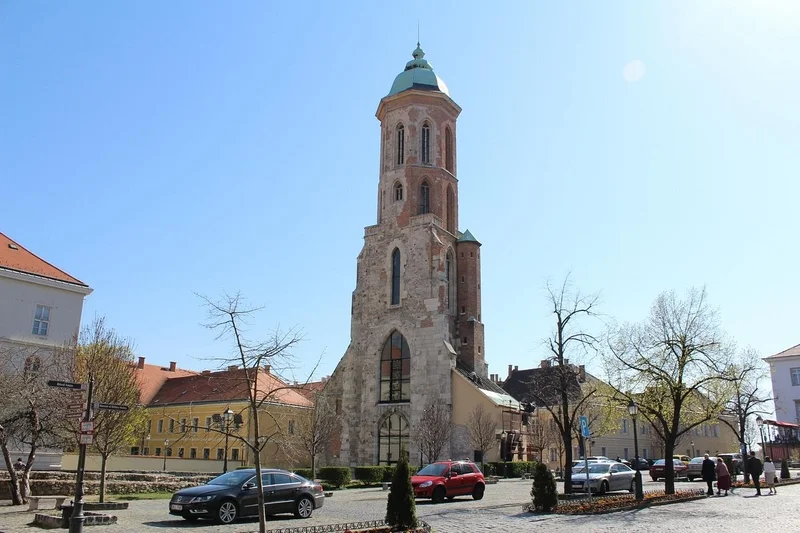
It is one of the oldest in Budapest. It was built in the Gothic style in the 13th century. But it was completely destroyed in 1686 and only restored in the 17th century, but already in the Baroque style. After the Second World War, ruins remained from it, which were demolished under the rule of the communists, only the bell tower remained, which we can observe today. Also, next to the tower you can see restored ruins and a bronze copy of a 1000-year-old Hungarian coronation robe.
12. Military Museum
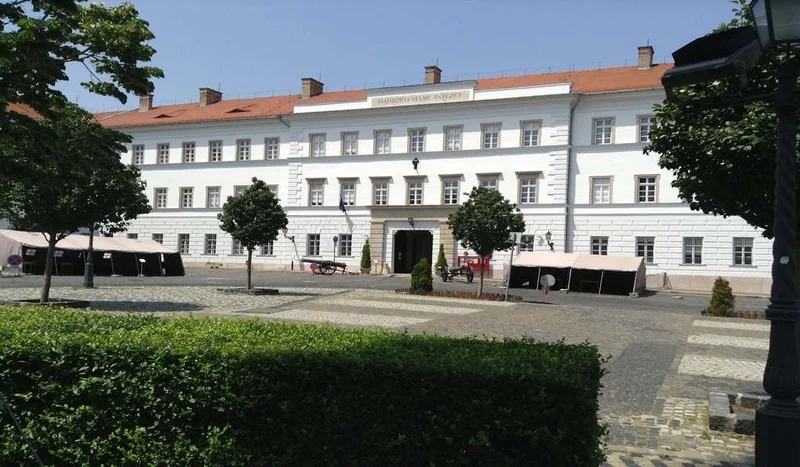
It is located on three floors and here you can see collections of: military equipment; military uniform; awards, orders; documentation; weapons; flags; coins. Also here you can see expositions showing the course of battles, and in front of the museum there are cannons and some types of weapons. Not far from the museum there is an observation deck with a magnificent view of the city.
13. Adam Clark Square
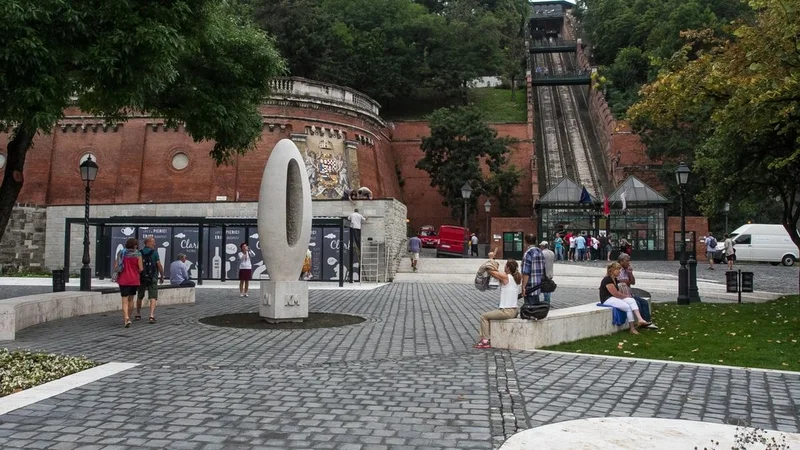
It is located between the ascent to Buda Hill and the chain bridge and is considered the official center of Budapest. The area is small, but here you can see: a beautiful view of Pest, the Kilometer Zero stone, the Tunnel under the Castle Hill, the Funicular to the Castle Hill.
14. Széchenyi Chain Bridge
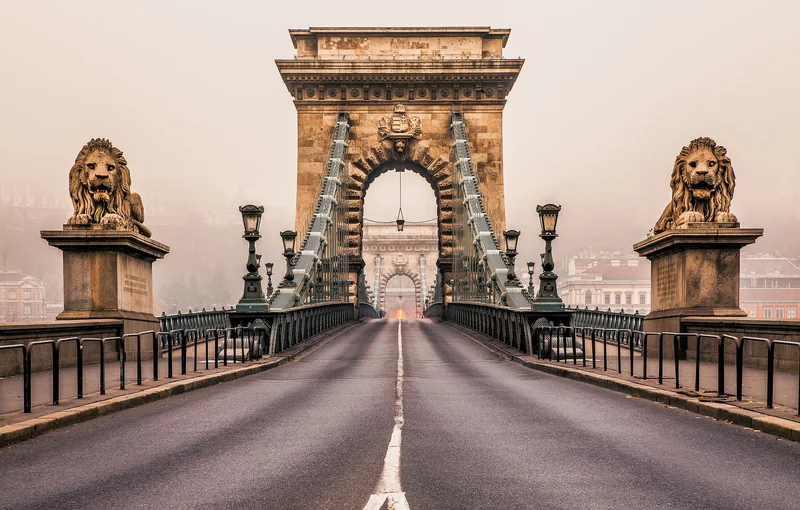
The bridge connects Buda (Adam Clark Square) and Pest (Istvan Széchenyi Square). On the left bank of the bridge are the Gresham Palace and the Hungarian Academy of Sciences, and on the right - the Kilometer Zero Stone and the lower station of the Siklo funicular. Opened in 1849, it was the first permanent bridge across the Danube. And at the time of discovery was considered a wonder of the world. The bridge played an important role in uniting Buda and Pest into one city, Budapest.
15. Margaret Bridge
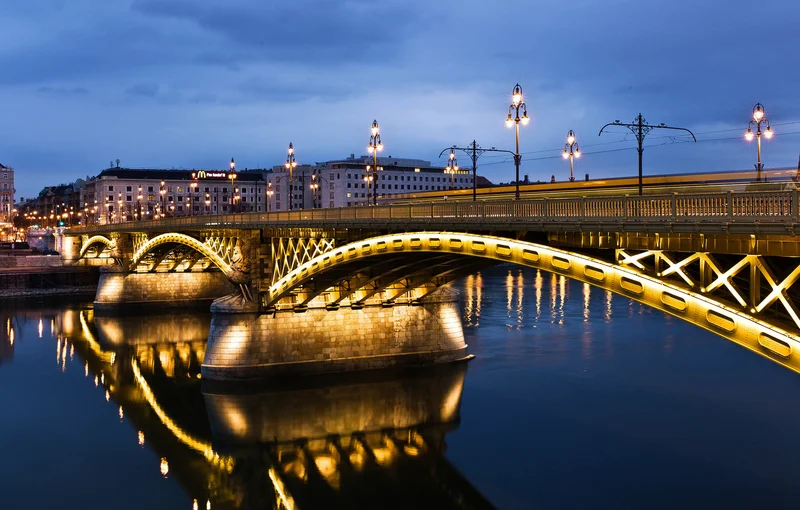
The second permanent bridge across the Danube after the Szechenyi Chain Bridge. Built in 1872-1876. Connects Buda and Pest and has access to Margaret Island.
16. Margaret Island
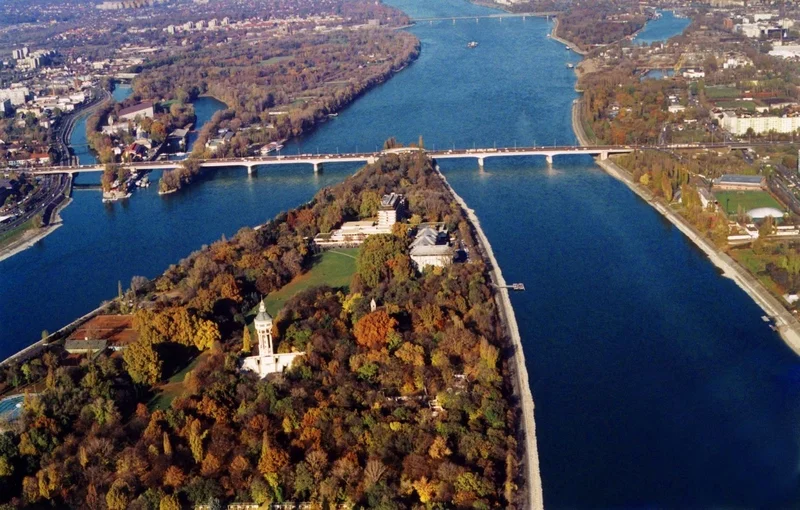
Located between the Margaret and Arpad bridges. Almost all the sights of the island are free to visit, these are: a musical fountain, the ruins of the Franciscan Cathedral and the Dominican convent, the Church of St. Michael, the Japanese garden.
What to see in Budapest: day two
The second day should be devoted to exploring the center of Budapest.
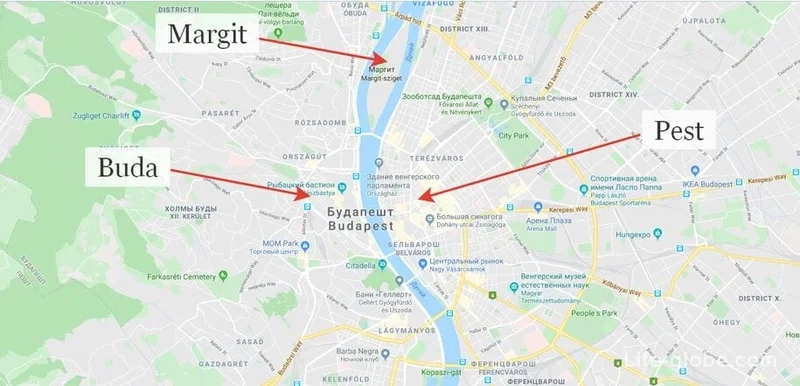
1. Lajos Kossuth Square
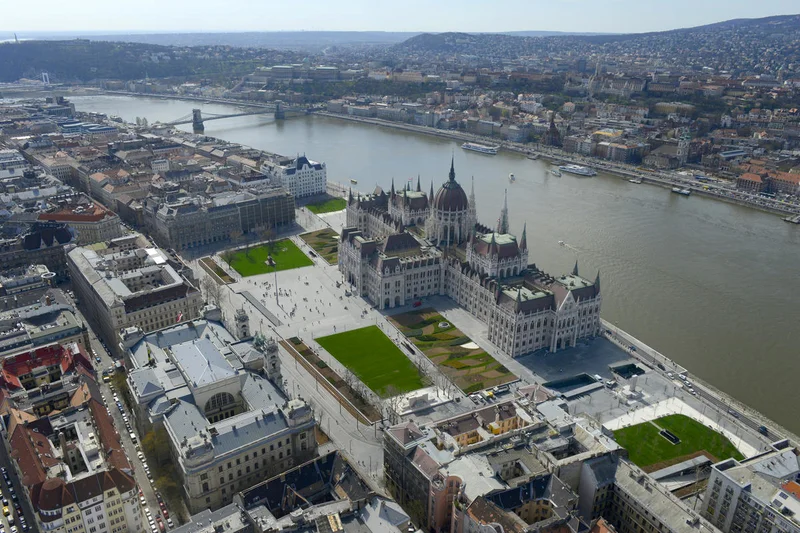
Or simply Kossuth Square - the most famous and visited square in Hungary. Located on the side of Pest, it appeared in the city plan in 1804. Here are some of the most famous buildings and monuments of the city, which we will discuss below.
2. Hungarian Parliament Building
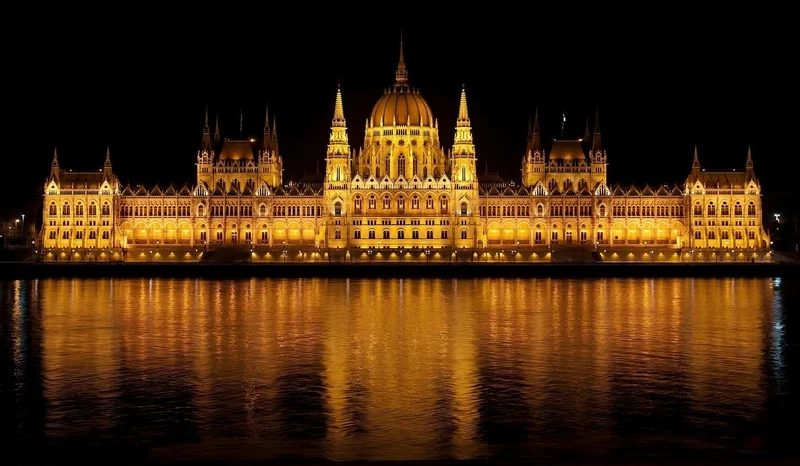
The visiting card of Budapest, the symbol of Hungary and the most popular place for tourists to visit. The western façade of the parliament faces the Danube, while the others face Kossuth Square. The decision to build it was made in 1843, but it had to be postponed due to the Hungarian Revolution that began soon after. The construction plan was resumed only in 1873 - after the unification of Buda and Pest into one city. The site for construction was chosen between the first two permanent bridges of the city - the Chain Bridge and the Margaret Bridge. The Parliament was built in neo-gothic style with elements of oriental architecture. This is the largest building in Hungary and has: 10 courtyards, 29 stairs, 691 rooms. The height of the central dome is 27 m. Inside the building there is a small museum of the parliament.
3. Shoes on the Danube Bank
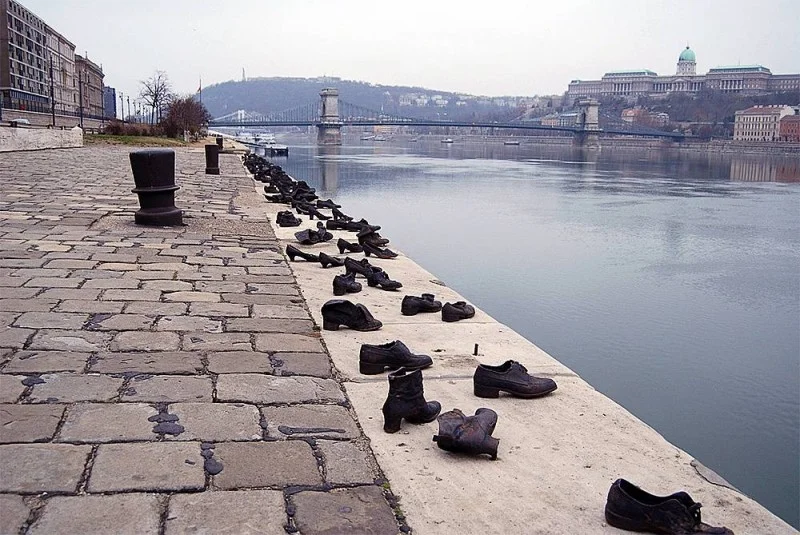
The Holocaust Memorial was erected in 2005. It is located about 300 meters from the Hungarian Parliament. On the Danube embankment there are 60 pairs of worn shoes: children's, men's, women's. They are made of iron. In 1944-1945, members of the Hungarian Nazi Arrow Cross Party carried out mass executions of Jews. They were taken to the river bank, their hands or feet tied. And to save bullets, they shot only at the first one, falling, he pulled the rest behind him. The number of victims is in the thousands, but the exact number is unknown.
4. Liberty Square
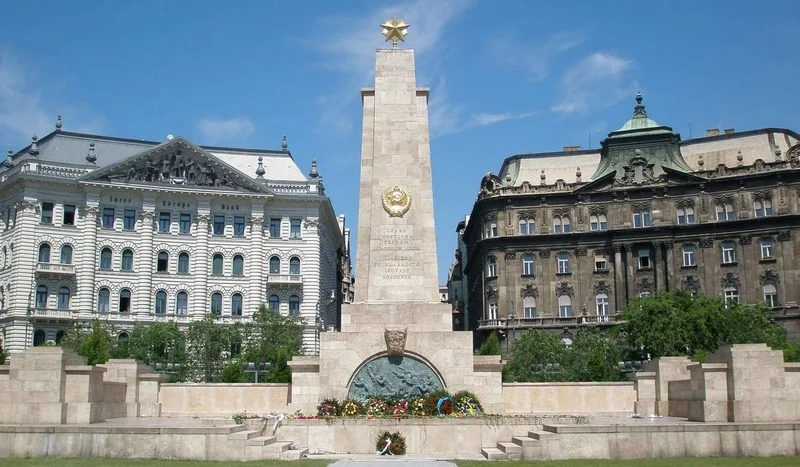
One of the main squares of Budapest is located on the Pest side, in the tourist part of the city. The square was formed in 1897 on the site of the demolished Neugeboide barracks, which served as prisons under Austrian rule. It is a square with a fountain, a playground, and places for recreation. Surrounded by buildings: the Hungarian National Bank, the home of the Budapest Stock Exchange, the US Embassy, the Former Headquarters of Inter-Európa Bank, the Swabian House. We also recommend paying attention to the monuments and monuments located on the square: a memorial to Soviet soldiers; a monument to the victims of the Hungarian occupation, a monument to US Army General Harry Hill Bandholtz, a monument to George W. Bush, a monument to Ronald Reagan.
5. Hungarian State Opera
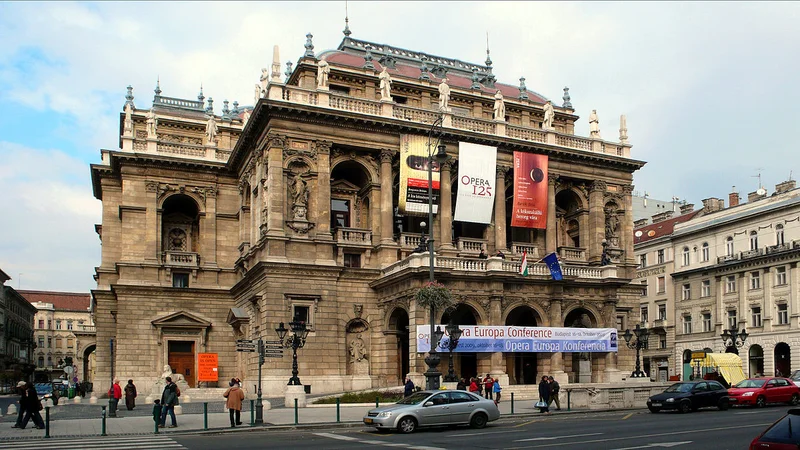
The largest Hungarian opera house is located in the VI district, on Andrássy Avenue. The building was built in 1884, after the opera troupe separated from the National Theatre. The style of the building is Neo-Renaissance, the decorations are in the Baroque style. The building consists of four parts: reception hall, auditorium, stage and technical rooms. The capacity of the theater is 1261 seats, and in terms of acoustics the theater ranks third in Europe, after the Milan and Paris Opera Houses.
6. St. Stephen's Basilica
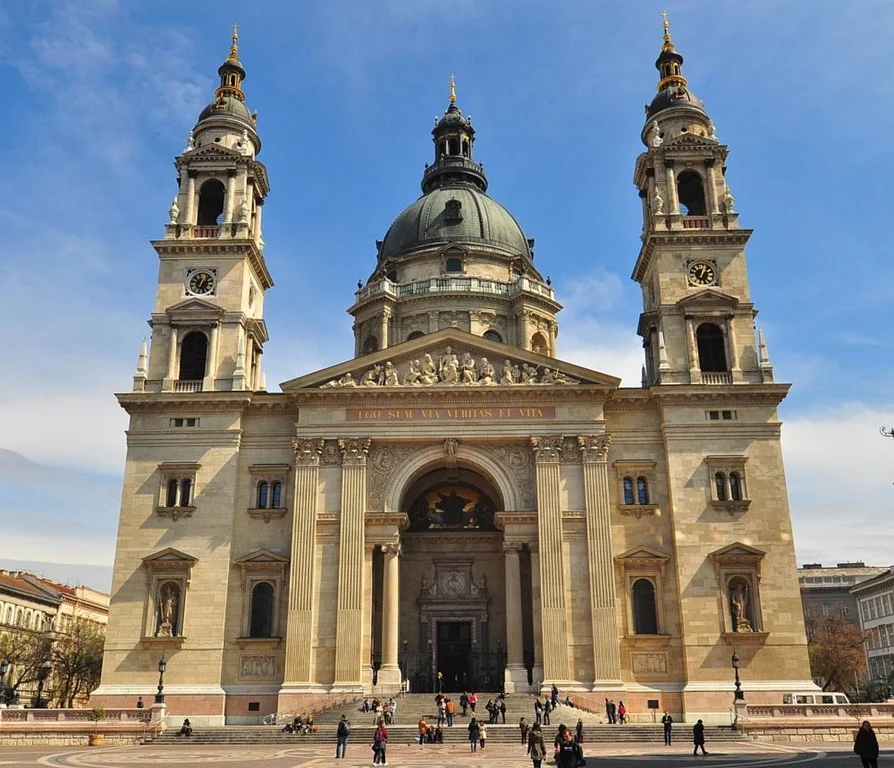
Along with the building of the Hungarian Parliament, it is the hallmark of Budapest. This is a Catholic church named after the first king and founder of Hungary, Istvan the First (or St. Stephen). The building impresses with its architecture and interior decoration. At the same time, the Basilica is not only a temple, but also a place for concerts and one of the best viewing platforms in the city.
7. Erzsebet Square
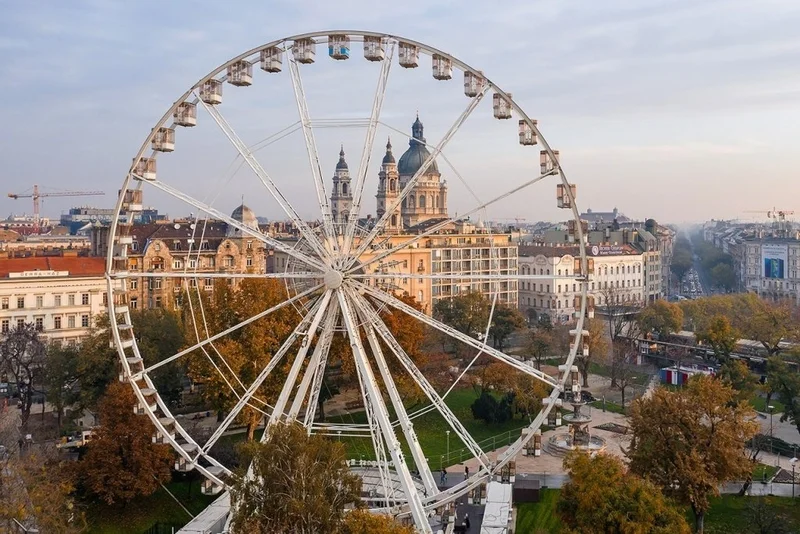
In the 18th century, on the site of the square, there was St. Istvana City Cemetery. But with the growth of the city, it was decided to transform it into a fairground. In 1858, the square was given its current name in honor of the wife of the Austro-Hungarian monarch Franz Joseph - Elizabeth (Princess Sisi). On the territory of the square there are: a playground, a skate park, a Ferris wheel, restaurants, bars, cafes, an underground club and a fountain.
8. Vörösmarty Square
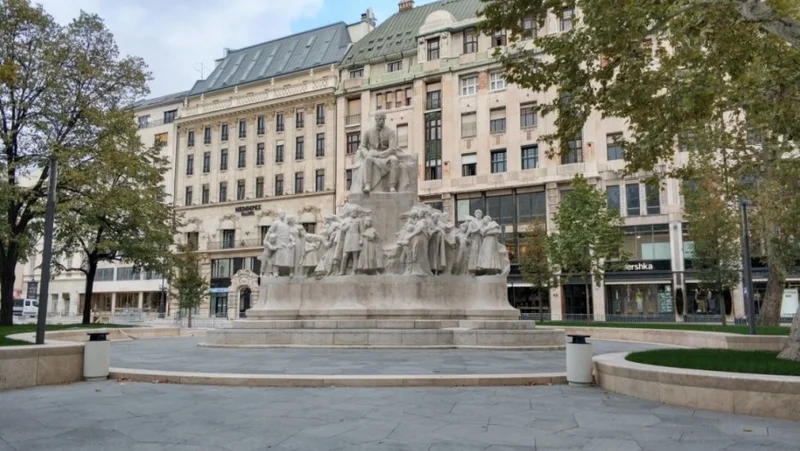
The pedestrian square in the center of Budapest is located in the V district of the city, between Vigado and Ferenc Deák streets. Vaci street ends with it. It is over 200 years old and during this time it has changed many names. On Christmas Eve there is a Christmas market.
9. Klotild Palaces
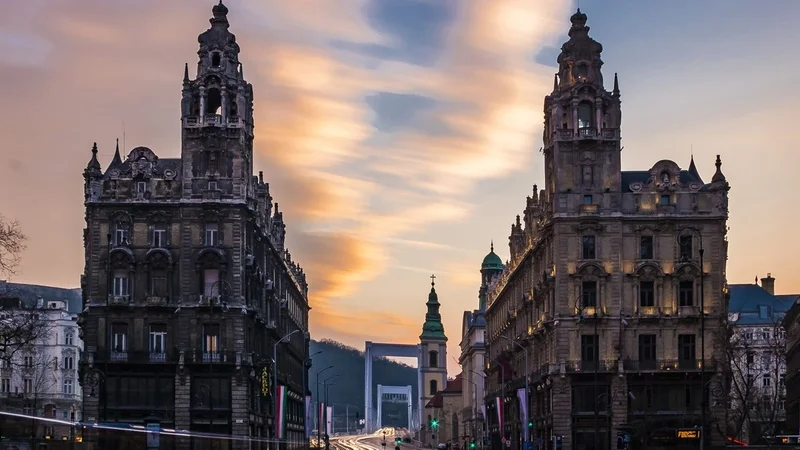
Another name "Stone twins for the princess" is located on Sabadshayto street, not far from the Erzsebet bridge. These are two residential buildings built in 1902 by order of Archduke Joseph Clotilde. Style - historical with elements of rococo. Palaces are exactly the same. Today, only the upper floors remain residential, on the ground floor there are shops, cafes and the Budapest Gallery.
10. Elizabeth Bridge
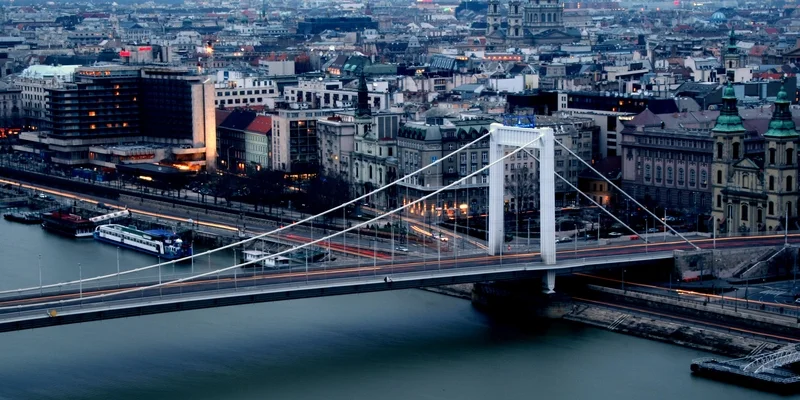
It connects Buda and Pest and is located on the narrowest section of the Danube. Named after the Austrian Queen Elisabeth of Bavaria. Its length is only 290 meters. Like all bridges in Budapest, it was badly damaged during World War II. But it is the only bridge that could not be restored, so it was rebuilt and opened in 1964. In the evening, the bridge is illuminated with bright lights.
11. Vaci Street
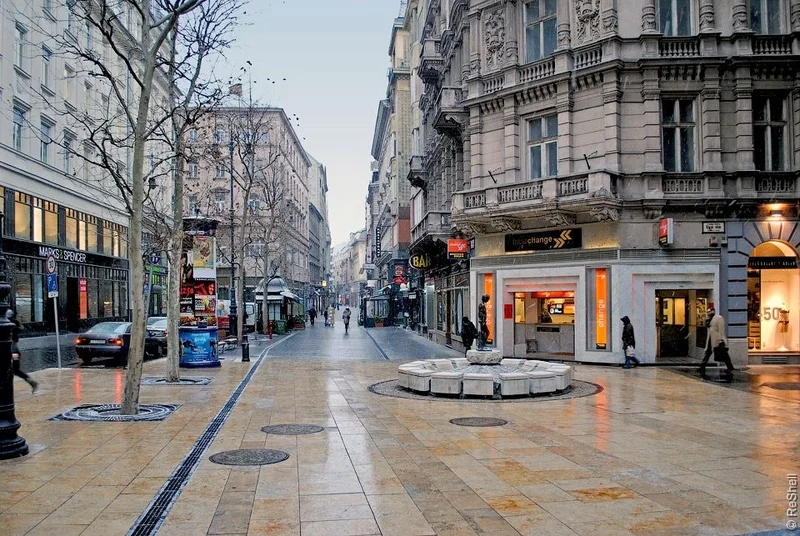
Main pedestrian street in Budapest. It starts from Vörösmarty Square and stretches to the Central Market on Fö Vam Square. The length of the street is 1300 meters and it dates back to the 18th century. A large number of shops, cafes, restaurants and shopping centers are concentrated along the street.
12. Central Market
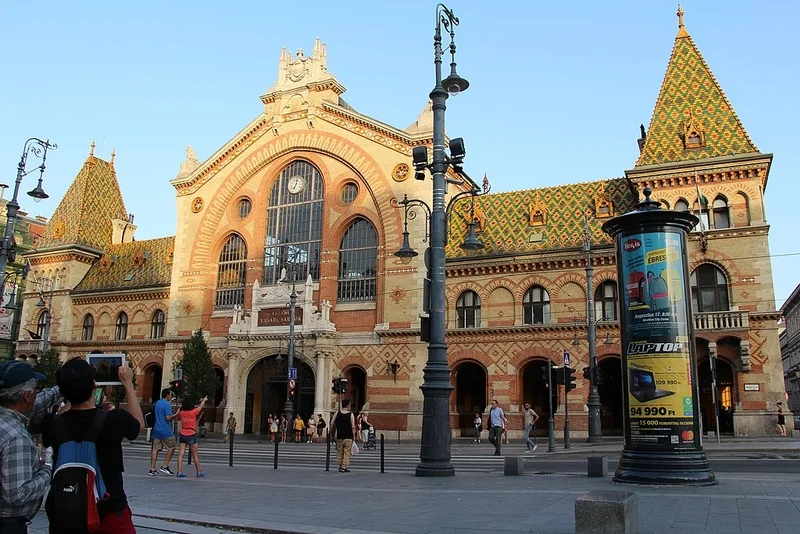
One of the iconic sights of the city and the main, oldest and largest market in Budapest. It was built in 1897 and is an architectural monument. It is located next to the Freedom Bridge, on Customs Boulevard. Vaci Street ends at the market. The building of the market is two-story, the total area is more than 10 thousand square meters. m. In the market you can buy both food, clothes and souvenirs.
13. Liberty Bridge
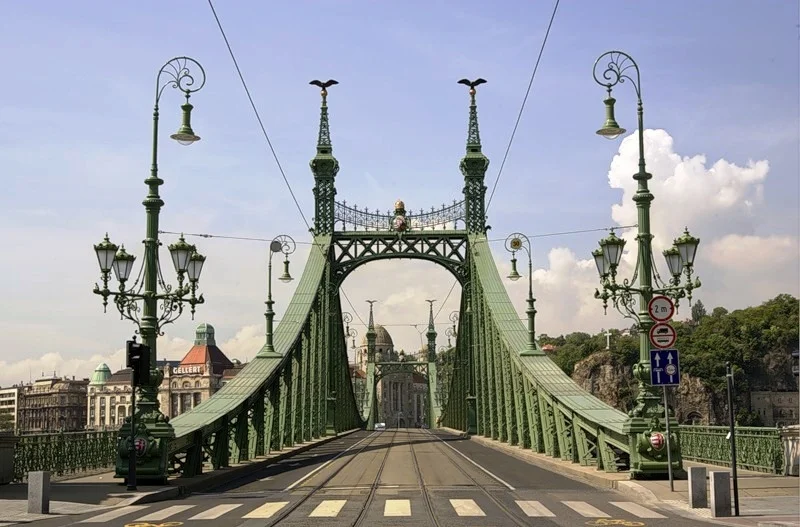
The bridge over the Danube connects St. Gellert Square and Fövam Square. Third permanent bridge in Budapest. Built in 1894-1896, the first name is the Customs Bridge (the building of which stood on the Pest embankment. The length of the bridge is 333.6 m, and the width is 20 m.
14. Hungarian National Museum
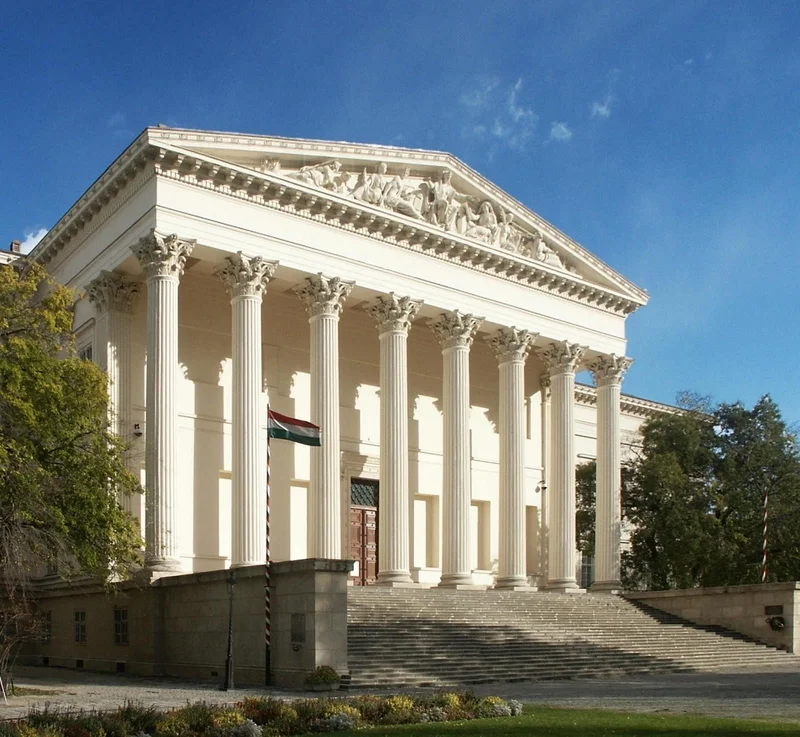
This is the best place to get acquainted with the history of Hungary. The museum is located in the center of Budapest, in the Palace Quarter, where rich aristocrats built many beautiful mansions for themselves. The building was built in the classical style and is surrounded by a garden. The museum is dedicated to the history of Hungary from prehistoric times to the present day, accumulating more than a million exhibits. Here you can see, for example, the Hungarian coronation robe of St. Stephen, a collection of silverware from the era of the Roman Empire, Mozart's clavichord, Esterhazy's baritone, Marie Antoinette's harp, the pianos of Beethoven and Liszt.
15. Dohany Street Synagogue
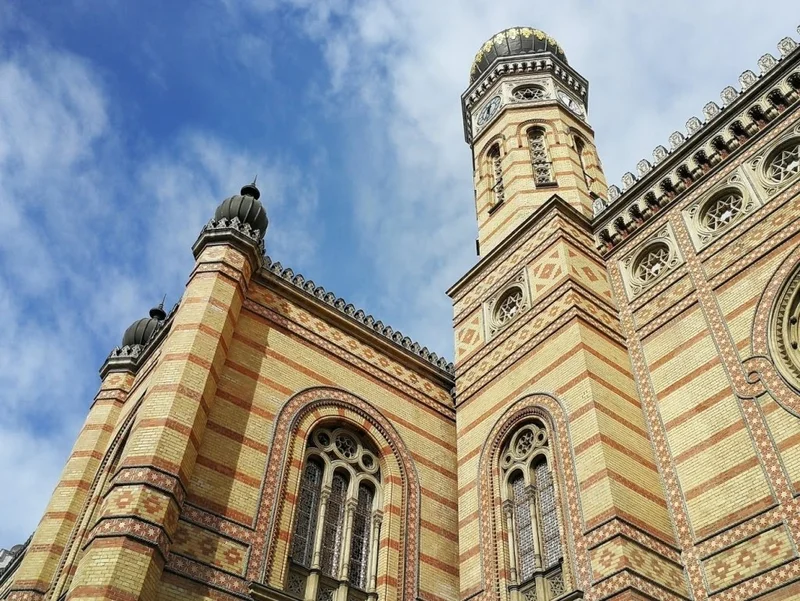
It got its name not by chance - it is considered the largest synagogue in Europe, designed for 3,000 people. Built in the 19th century and located in the Jewish quarter of Pest. It is a two-storey building with three naves. The façade is decorated with floral ceramics and rose windows. Two towers 44 meters high rise above the main building. There is a Jewish cemetery in the courtyard of the synagogue, where about 7,000 people are buried - victims of the Nazis of the Second World War. The building of the Jewish Museum also adjoins the synagogue.
What to see in Budapest: day three
The last day can be spent in different ways, but if you want to see more of the sights of Budapest, then below you will see places that may interest you.
1. Andrassy Avenue
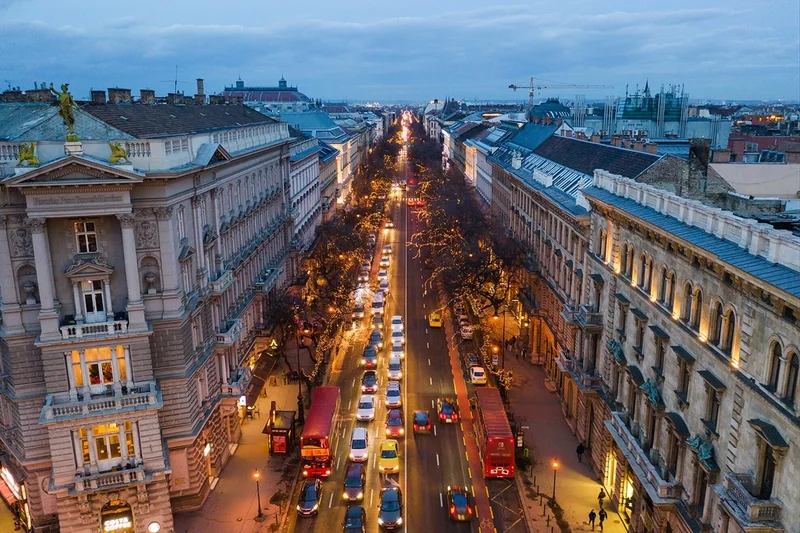
The main front avenue of Budapest. He was even nicknamed "Budapest Champs Elysees" for grace and elegance. The 2.5 km long avenue connects two squares: Ferenc Deák Square and Heroes' Square. And under the avenue, the first metro line in continental Europe was laid (in general, the first metro in Europe is located in London). At various times, the avenue bore the following names: Radial, Andrassy, Stalin, Youth, People's Republic. What interesting things can be seen walking along the avenue: the Opera House, the Museum of Fine Arts, the "House of Terror", the Franz Liszt Museum, the Drexler Palace, the Paris Department Store, the Budapest Puppet Theater, the Hungarian University of Fine Arts, the Zoltan Kodály House Museum, the Museum of East Asian Art named after . Ferenc Hopp, Postal Museum. And of course, the avenue is also lined with boutiques, cafes and restaurants.
2. Heroes Square
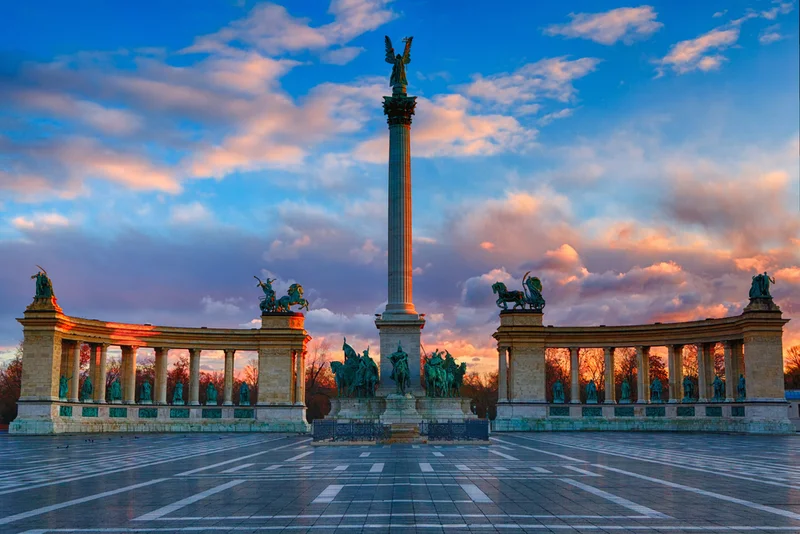
One of the main and famous squares of the Hungarian capital. It is located at the end of Andrássy Avenue and is part of the UNESCO World Heritage Site. The square was decorated in celebration of the millennium of Hungary in 1896. In the center of the square is the Millennium Memorial with the archangel Gabriel on top, seven Magyar leaders on a pedestal and two colonnades with sculptures of prominent Hungarians. The memorial is dedicated to the acquisition of the Motherland by the Hungarians. In front of the central column there is a stone memorial plate in memory of the soldiers of the two world wars.
3. Museum of Fine Arts
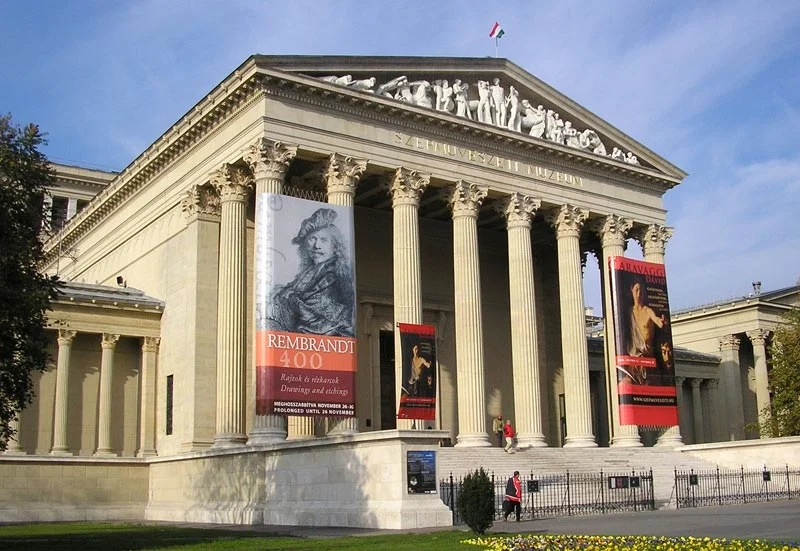
The largest collection of fine art in Hungary. It is one of the most famous museums in Europe. The museum is located on the Heroes' Square and is made in the neoclassical style. The museum was founded in 1896. The basis of the collection in the museum is the private collection of the Hungarian aristocratic Esterházy family. Here, as in many museums, there are permanent and temporary exhibitions. Permanent: Egyptian Art; Renaissance Hall, Romanesque Hall; European art 1250-1600; European sculpture 1350-1800; Art in Hungary 1600-1800; Gallery of graphics and engravings; Gallery of new masters. Today here you can see the works of Raphael, Titian, Leonardo da Vinci, El Greco, Durer, Rembrandt, Rubens, Goya, Manet and many other famous artists.
4. Mucharnock Exhibition Hall (Modern Art Gallery)
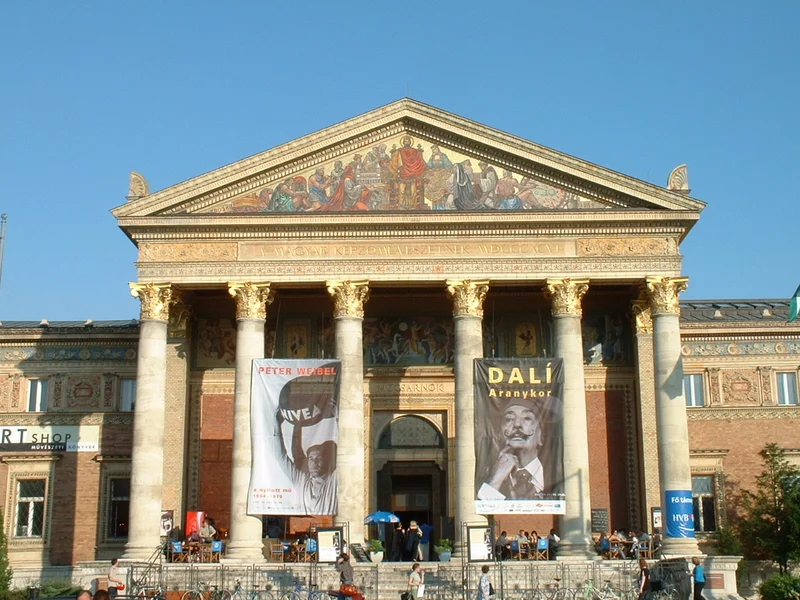
The art gallery is located on Heroes' Square, opposite the Museum of Fine Arts. The building with six colonnades and colorful mosaics opened in 1895. The gallery does not have its own permanent exhibition, but is used for various exhibitions of Hungarian and foreign contemporary art.
5. City Park Varosliget
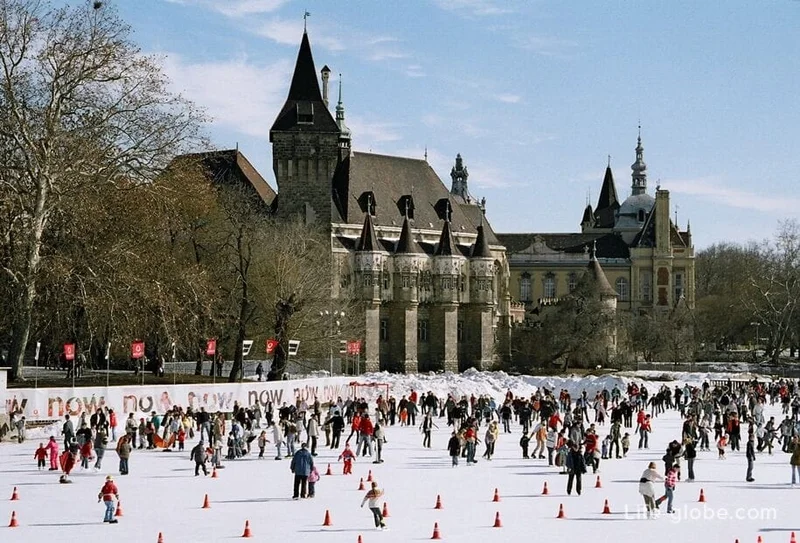
The largest green reserve in Budapest, located next to the Heroes' Square. It is the cultural center of the city and a favorite place for walks of local residents and guests of the city. Various holidays and festivals are constantly arranged here. And you can also enjoy the beauty and grandeur of the Vajdahunyad Castle, which is located in the southern part of the park.
6. Vajdahunyad Castle
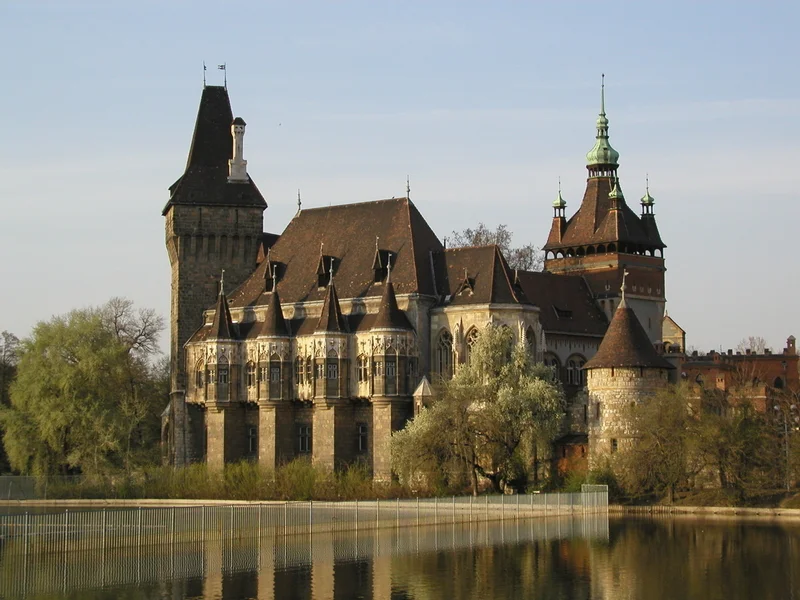
In 1896, during the celebrations dedicated to the millennium of Hungary, a pavilion of plywood, papier-mâché and wood was erected on the site where the celebration took place. He represented a mixture of different architectural styles, including the most famous buildings in Hungary. But people liked it so much that after the celebration it was decided to build it in the same place, but already in stone. Near the castle there is a monument to its architect - Ignaz Alpar. The project was made according to all the rules of the Middle Ages: a moat with water was dug in front of the castle, and in order to get inside the castle, you need to go over the bridge, and then through the gate. On the territory of the castle you can see a copy of the Roman monastery and a small chapel, a building that resembles a knight's citadel, as well as a tower that is a copy of the tower of the Shegeshvar fortress. And next to the palace there is a monument to Anonymous - an unknown chronicler who wrote the "Act of the Hungarians" in the 12th century.
7. Szechenyi Thermal Bath
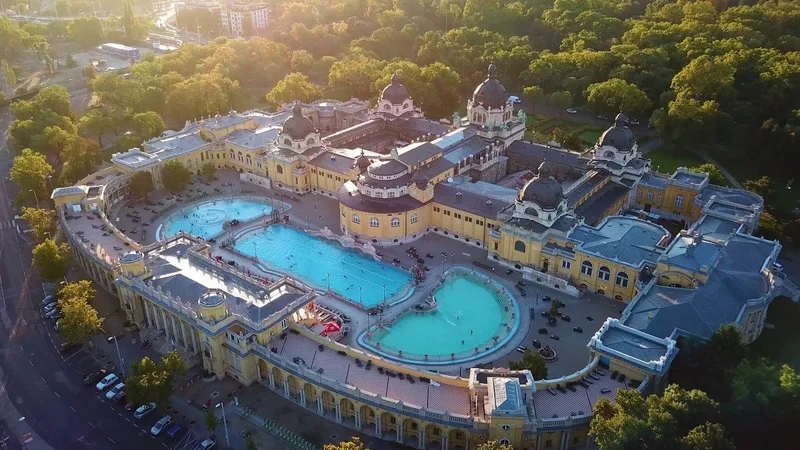
The most popular bath in Budapest, not only among tourists, but also among locals. Located in the Varosliget park. This is the largest bath in Europe and it is fed from the hottest spring. The complex consists of three external and fifteen internal pools. Various types of therapy and a day balneary are also available here. If you do not plan to visit it, we recommend that you at least see it from the outside, since the bath building itself is unusually beautiful. It is made in the Neo-Renaissance style with elements of classicism.
Public transport in Budapest
Trams
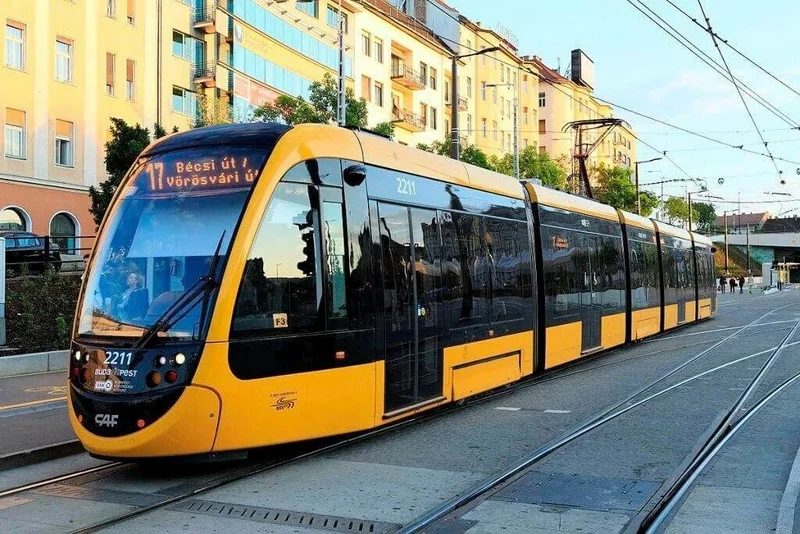
Modern trams in Budapest are the longest trams in Europe. The most popular among tourists are trams No. 2 and No. 2M (they run along the right bank of the Danube, along the embankment and past the Hungarian Parliament).
Underground
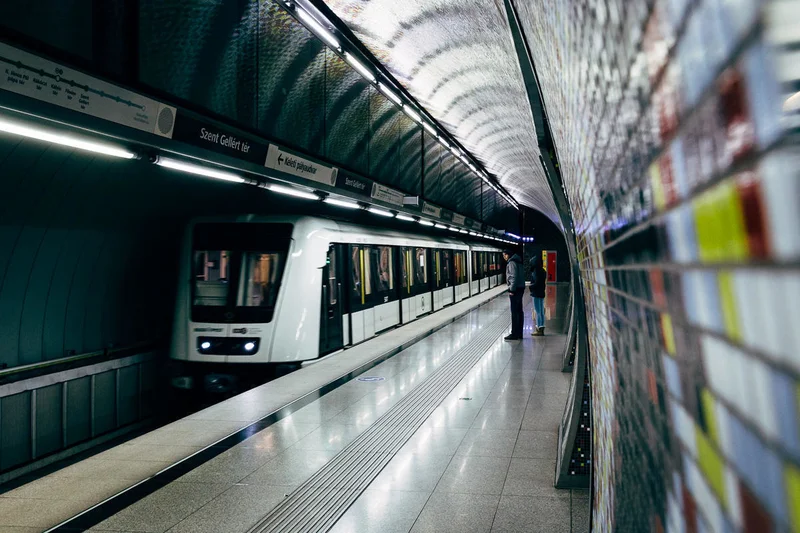
There are 4 metro lines in Budapest:
Yellow line M1 (from 04:32 to 23:32): Mexikói út – Vörösmarty tér. Passes on the Pest side of the Varosliget park, along Andrássy Avenue.
Red line M2 (from Mon to Thu, on Sun and holidays from 04:27 to 23:27, on Fri and Sat from 04:27 to 00:27): Déli pályaudvar – Örs vezér tere. Links the sides of Buda and Pest.
Blue line M3 (on working days from 04:21 to 23:21, on weekends from 04:21 to 23:41): Újpest-központ – Lehel tér – Nagyvárad tér – Kőbánya-Kispest. Passes on the side of Pest. It unites the urban area of Ujpest with the center and district of Kispest.
Green line M4 (from Mon to Thu, on Sun and holidays from 04:27 to 23:27, on Fri and Sat from 04:27 to 00:27): Keleti pályaudvar – Kelenföld vasútállomás. Links the sides of Buda and Pest and two railway stations.
Buses
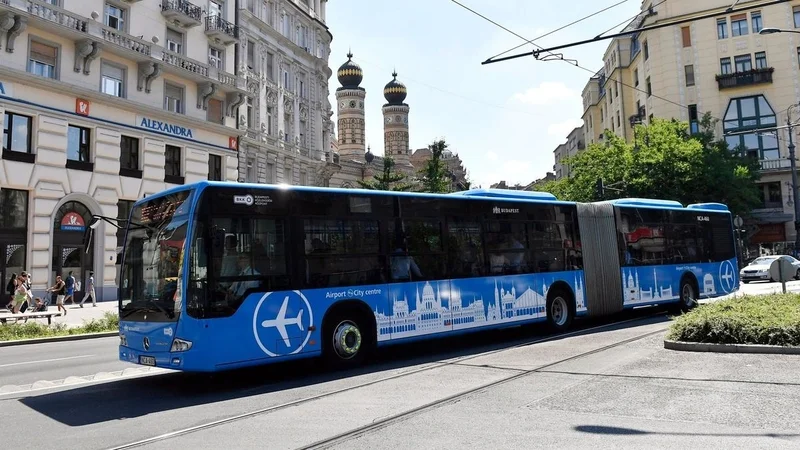
The first buses appeared in Budapest in 1915. Transport in Budapest runs on schedule. Buses also run at night, depending on the route every half an hour or an hour.
Trolleybuses
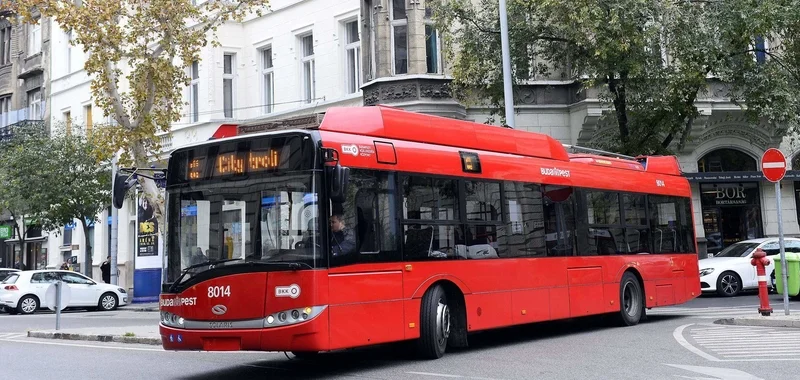
An interesting fact: the numbering of the lines starts from No. 70, since in 1949 the first trolleybus in Budapest was assigned the number 70 in honor of Stalin's 70th birthday.
River trams
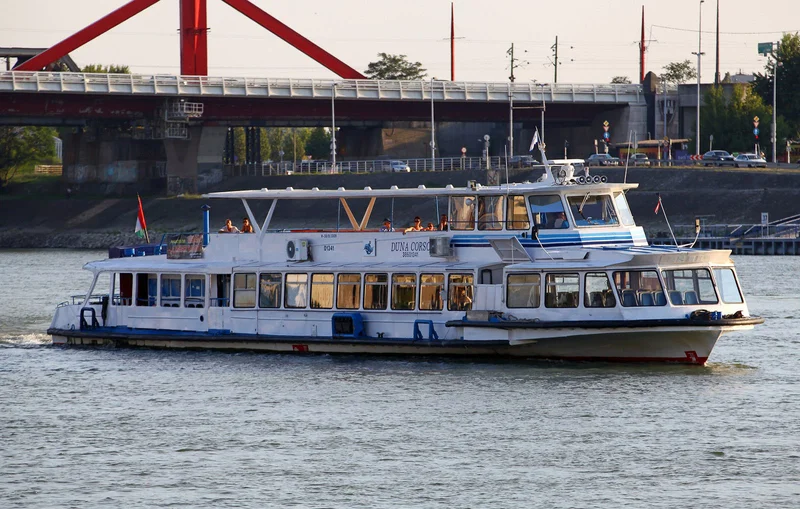
In addition to sightseeing boats, boats run between Buda and Pest in the warm season as a form of public transport.
City trains
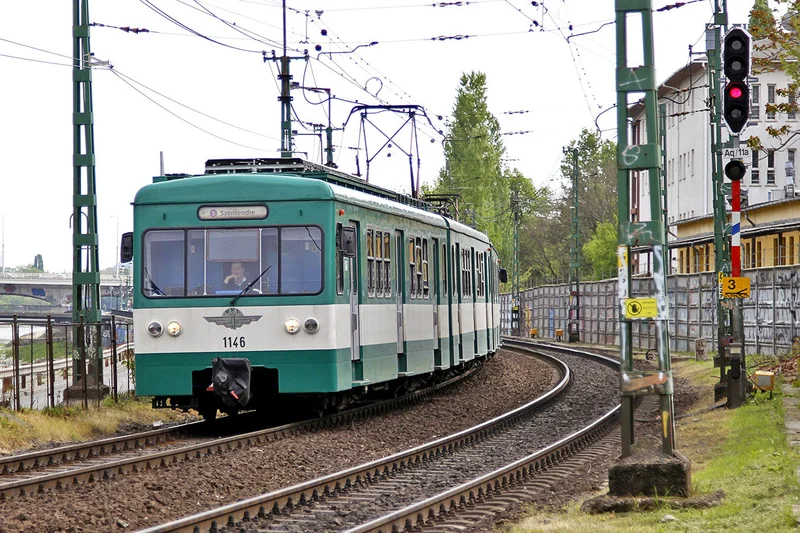
In Budapest, the train is part of public transport. There are uniform fares within the city, but if you go outside of Budapest, you need to buy a separate ticket. Lines run: H5, H6, H7, H8, H9.
Taxi
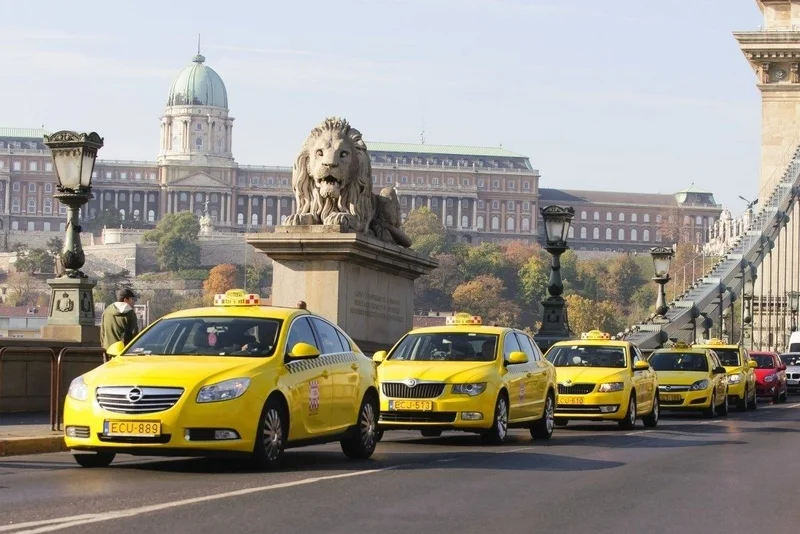
Taxi cars in Budapest are bright yellow. The most popular services are Bolt and Fotoxi.
Prices for public transport in Budapest
Where to eat in Budapest
Hungarikum Bistro (📍Steindl Imre ut., 13)
A cozy bistro with a touch of antiquity, traditional cuisine and music. Located 5 minutes walk from the Parliament.
Menza (📍Liszt Ferenc tér, 2)
Retro cafe with traditional Hungarian cuisine. Located near Andrássy Avenue, on Franz Liszt Square.
Paprika Vendéglő (📍Dózsa György ut., 72)
A small colorful restaurant of Hungarian cuisine in a rustic style. Located near the park Varoshliget.
Café Gerbeaud (📍Vörösmarty tér, 7-8)
The famous old classic pastry shop in the aristocratic style of the 19th century, is considered a landmark of Budapest. Located at the end of the main tourist street Vaci, closer to the waterfront.
New York Café (📍Erzsebet korut, 9-11)
It's funny, but one of the most popular restaurants of national Hungarian cuisine in Budapest is called New York. Located in the Jewish quarter, not far from the Great Synagogue.
Szimpla Kert (📍Kazinczy ut., 14)
Ruin bar, landmark of Budapest. Located in an abandoned building in the Jewish quarter.
Mazel Tov (📍Akácfa ut., 47)
Mediterranean restaurant. Located in the courtyard of a 19th century building.
Onyx (📍Vörösmarty tér, 7)
A restaurant with two Michelin stars. Local products are served according to French techniques. Located near Vörösmarty Square.
Alma & Korte Restaurant (📍Lorinc pap ter, 3)
The restaurant is relatively new, with a romantic interior and light live music. Located near the Hungarian National Museum.
Retek Bistro (📍Merleg ut., 10)
Restaurant of Hungarian cuisine. Located near the Chain Bridge.
Things to Do in Budapest
1. Thermal Baths
It is simply impossible to visit Budapest and ignore the baths. Choose a day and time and be sure to visit one of the local baths. And there is plenty to choose from (everywhere there are indoor and outdoor pools):
Széchenyi (📍Állatkerti korut, 9-11)
The largest baths in Budapest: 18 pools, 14 saunas, jacuzzi, artificial whirlpools.
Of. website: https://www.szechenyibath.hu/
Gellert (📍Kelenhegyi út., 4)
It consists of 8 thermal pools (temperature from 26 to 38 degrees), an 80-degree Finnish sauna with an ice barrel outside, free water aerobics classes every hour.
Of. website: https://www.gellertbath.hu/
Rudash (📍Döbrentei tér, 9)
The thermal part and pools are paid separately. Sat and Sun - mixed days, women's day Tuesday, other days - only men's.
Of. website: https://www.rudasfurdo.hu/
Király (📍Fő ut., 84)
Turkish baths Kiraly with a fabulous atmosphere - overhanging ceilings and subdued lights.
Of. website: https://www.kiralyfurdo.hu/
Lukács (📍Frankel Leó ut, 25-29)
4 thermal baths (temperature from 24 to 40 degrees), jacuzzi and outdoor whirlpool.
Of. website: https://www.lukacsfurdo.hu/
Veli-Bay(📍crossing Árpád fejedelem ut., 7 и Frankel Leó ut., 54)
The oldest bath in Budapest. Here are: thermal pools, infrared and classic saunas, steam room, Kneipp bath, jacuzzi.
Of. website: http://www.irgalmasrend.hu/site/velibej/ltalnosinformcik
2. Budapest Zoo & Botanical Garden (📍1Állatkerti körút, 6-12)
Built in 1866, it is the largest and oldest in Hungary. The area is almost 11 hectares, there are about 3,500 plant species and 750 animal species.
Of. website: https://zoobudapest.com/
3. Tropicarium-Oceanarium (📍Nagytétényi út., 37-43, shopping center «Campona»)
The largest in Europe. It will be interesting for both adults and children. Here you can get acquainted with representatives of exotic flora and fauna.
Of. website: http://tropicarium.hu
4. Casino Las Vegas Casino (📍Széchenyi Square, 2)
Of. website: https://lasvegascasino.hu
5. Kerepesi Cemetery (📍Fiumei út., 16-18, 1086)
The most famous cemetery in Budapest, where many prominent personalities of Hungary are buried).
6. Boat trip
Be sure to take a boat ride on the Danube. There are a lot of offers - choose what you like. The views are impressive both during the day and at night.
Three days in Budapest just fly by, because during this time you want to see so much! But, following the route proposed by us, you will get acquainted with the main sights of Budapest and plunge into the atmosphere of the city.
6. Karting
More details about it in our article about karting centers in Budapest.
And so that you do not forget anything, we have prepared a checklist for the trip for you..
And don't forget to check the weather forecast :)

